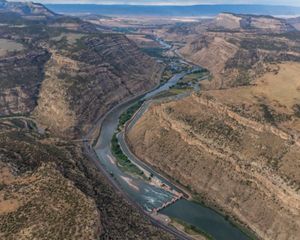The Water Resources Development Act Supports our Waterways, Wildlife and Communities

Biennial water resources development legislation is an opportunity for Congress to strengthen communities using nature-based solutions proven to lessen flood impacts, improve natural areas and support the economy.
Through cost-effective, nature-based approaches, the U.S. Army Corps of Engineers (the Corps) can deliver projects that protect America’s natural resources, support economic and recreational opportunities and enhance community resilience in an equitable manner.
The Water Resources Development Act (WRDA) is an opportunity for Congress to support the work of the Corps and strengthen communities using nature-based solutions.
Congress has demonstrated its commitment to and support for these strategies in previous legislation, and it must do so again in WRDA 2024 while also ensuring the Corps properly implements prior WRDA requirements.

Nature-Based Solutions at the Corps
The water resources legislation signed into law in 2016 was a landmark success for advancing natural infrastructure within the Corps.
For the first time, Congress directed the Corps to consider natural and nature-based features—alone or in combination with gray infrastructure—when studying the feasibility of flood-risk management, storm damage reduction and ecosystem restoration projects.
WRDA legislation in 2018, 2020 and 2022 reiterated and expanded that focus on nature-based solutions.
Conserving and protecting natural resources often provides the most effective and cost-effective line of defense against storms and extreme weather events, all while delivering a host of additional environmental and community benefits.
For example, coastal wetlands prevented more than $625 million in property damages during Hurricane Sandy and reduced property damages throughout the Northeast by 10%, on average.
WRDA Projects
Project Recommendations
No results are shown. To see results, turn on the toggle switches in the legend.
- Alabama River Project
-
Alabama River Project
Alabama River Project
Habitat and species loss is occurring on the Alabama and Cahaba Rivers, in Alabama, due to navigation structures on the Alabama River. To protect and grow the biodiversity on these rivers, we need to increase resiliency and conservation of freshwater ecosystems that allow fish passage up and down the river to and provide critical habitats.
- Cherryfield Local Protection Project
-
Cherryfield Local Protection Project
Cherryfield Local Protection Project
The Town of Cherryfield, Maine is working with partners to replace an aging dam on the Narraguagus River with a channel-spanning nature-like fishway. This project will open 320 miles of river habitat for fish passage while maintaining ice control for town safety. De-authorization of the project in WRDA 2024 is the next step in the process to replace the dam.
- Upper Mississippi River Restoration Program
-
Upper Mississippi River Restoration Program
Upper Mississippi River Restoration Program
The Upper Mississippi River Restoration Program was the first environmental restoration and monitoring program undertaken on a large river system in the U.S. TNC recommends Congress increase the authorization for long-term resource monitoring and restoration efforts in the Upper Mississippi River system (Minnesota, Wisconsin, Iowa, Illinois and Missouri) to $40 million per year.
- Hatchie-Loosahatchie Project
-
Hatchie-Loosahatchie Project
Hatchie-Loosahatchie Project
The Hatchie-Loosahatchie Ecosystem Restoration Feasibility Study examined the loss of freshwater, wetlands and other habitats on the Lower Mississippi River. It also studied the restoration efforts needed to reduce flood risk and support this floodplain. WRDA 2024 should authorize continued restoration for the Hatchie-Loosahatchie Mississippi River from miles 775-736 through Tennessee and Arkansas
Our 2024 Project Recommendations for WRDA
-
Reconnecting Rivers and Improving Dams in Alabama
WRDA 2024 should authorize improvements to the Claiborne and Millers Ferry Locks and Dams on the Lower Alabama River. This project will reconnect 585 miles of the Alabama and Cahaba rivers to the Gulf of America, reviving one of the most important waterways in the world. Adding natural bypass channels at both dams will support threatened and endangered species of sturgeon and will reduce the likelihood of other species being listed. TNC is the non-federal cost-share partner for this study.
-
Restoring the Lower Mississippi River
Authorized in 2018, the Hatchie-Loosahatchie Ecosystem Restoration Feasibility Study will model an approach to managing the Lower Mississippi River and implementing restoration efforts to address the needs of this important floodplain. WRDA 2024 should authorize continued restoration for the Hatchie-Loosahatchie Mississippi River from miles 775-736 through Tenn. and Ark. Covering 146,000 acres, the project includes side channel reconnections, forest restoration and recreation improvements.
-
Monitoring Upper Mississippi River Restoration
The Upper Mississippi River Restoration program fulfills Congress' direction to manage the Upper Mississippi River System as a nationally significant ecosystem. UMRR was the first federal program to combine ecosystem restoration, monitoring and science on a large river system. TNC recommends Congress increase the authorization for long-term resource monitoring and restoration efforts in the Upper Mississippi River system to $40 million per year to keep both sides of this program in alignment.
-
De-Authorizing Cherryfield Local Protection Proj.
The Town of Cherryfield, Maine is working with partners to replace an aging dam on the Narraguagus River with a channel-spanning nature-like fishway. This project will open 320 miles of river habitat for fish passage while maintaining ice control for town safety. De-authorization of the project in WRDA 2024 is the next step in the process to replace the dam. This project would reconnect the river and its fish populations including endangered Atlantic salmon back to the ocean.

Our 2024 WRDA Policy Recommendations
Reform of Corps Project Partnership Agreements (PPA). PPAs are legally binding documents that outline the responsibilities of non-federal cost-share partners and the federal government for water resource projects. As currently written, the PPA requirements restrict or deter non-federal entities from participating as cost-share partners. The non-federal sponsor typically has limited input and control into the project design and implementation and yet is held responsible for significant legal and financial project risk. TNC recommends removing or modifying certain PPA requirements to promote a more shared approach to liability and financial obligations and a true partnership with the Corps on water resource projects.






